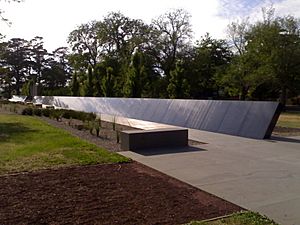Australian Ex-Prisoners of War Memorial facts for kids
The Australian Ex-Prisoners of War Memorial is a special place dedicated to Australians who were held as prisoners during wars. It was officially opened on February 6, 2004. You can find it in Ballarat, Victoria, near the Ballarat Botanical Gardens and next to Lake Wendouree.
Contents
Why This Memorial Is Important
This memorial is now known as the official National Prisoner of War Memorial for Australia. It honors more than 35,000 Australians. These brave people were held prisoner during the Boer War, World War I, World War II, and the Korean War. It is a place for all Australians to remember, honor, and find healing. The memorial helps visitors understand the courage, sacrifice, and strong friendships (mateship) of these prisoners of war.
How the Memorial Was Built
Early Ideas and Plans
From the 1950s to the 1990s, former prisoners of war from the Ballarat area met often. They talked about creating a special place to remember their experiences. The Australian Federal Government had sometimes promised to build a monument in Canberra, the nation's capital.
By the early 1980s, the Ballarat City Council gave some land near the city gardens. This was so local veterans could start their own memorial for Ballarat POWs. But by the mid-1990s, the Federal Government still had no plans for a monument in Canberra. This made the surviving POWs in Ballarat decide to act. They began planning a permanent memorial in their city. They wanted it to be mostly paid for by private donations, with little government help.
Bringing the Vision to Life
The Ballarat branch of the Returned and Services League (RSL) gave a lot of support. They hired a local artist named Peter Blizzard to design the memorial. His idea was much bigger than what the veterans first imagined. But everyone quickly supported the idea of a much larger monument. This new plan would honor all Australian POWs.
Money for the memorial came from many places. This included lotteries, private donations, and helpful groups like Tattersall's. The City of Ballarat, local businesses, and finally the Federal and Victorian State Governments also helped. Building the memorial started in early 2003. Much of the work and materials were given for free or at a very low cost.
Creating the POW Database
The Ballarat RSL, with help from volunteers, worked for over 10 years. They gathered names to create the first national list of Australian prisoners of war. Before 2004, the Australian Federal Government and the Australian Defence Force did not have a complete list of their POWs. Information was only kept on individual records in Defence archives in Melbourne. It is thought that some names might still be missing. The memorial has a special section to add more names later if they are found.
What the Memorial Looks Like
The Path and Walls
The memorial is about 130 meters (426 feet) long. It has a long pathway made of light-grey basalt stones. These stones look like railway sleepers, similar to those used on the Thai–Burma Railway. On the southern side, there are two black, shiny granite walls. These walls have the names of all known Australian prisoners of war carved into them. The names are listed in alphabetical order by the war they fought in. No military ranks are shown.
Water and Obelisks
A square pool of water separates the two walls in the middle. In this pool are six large basalt stone pillars, called obelisks. These obelisks show the names of the countries where Australian POWs were held. The obelisks in the water symbolize how Australian POWs were cut off and alone, far from their homeland, separated by the ocean. One of the six obelisks is purposely tipped over and broken. This represents "The Fallen," those who died as prisoners.
Focal Point and End of the Journey
On the northern side of the memorial is a larger basalt obelisk. This acts as the main focal point and a cenotaph (a monument to those buried elsewhere). It is surrounded by the flags of the Royal Australian Navy, the Royal Australian Air Force, the Australian Merchant Navy, and the Australian National Flag, which represents the Australian Army.
At the western end of the memorial, there is another stone wall. Water flows down this wall, and the words "LEST WE FORGET" are carved into it. This marks the end of the journey through the memorial. The memorial is surrounded by native plants, jungle grasses, and different types of trees.
Gallery






